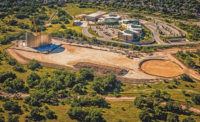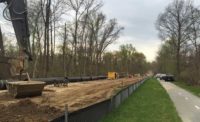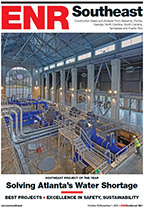In June 2010, the Schultz fire tore through northern Arizona, charring more than 15,000 acres, forcing the closure of several monuments and leading to the evacuation of hundreds of homes.
The fire had swept through hillsides along the San Francisco Peaks, and when monsoon storms followed, flooding triggered major debris flows that caused extensive damage to a pipeline that is a prime water source for nearby Flagstaff, Ariz. The pipeline collects water from a number of springs and delivers the water by gravity to the city's public works facilities.
Initial emergency repairs were made to Waterline Road in the immediate aftermath of the wildfire, but the repairs were unable to withstand the steady progression of heavy rains and were eventually washed out. The road was damaged or rendered impassable in at least 28 locations, and the pipeline was exposed in 17 locations and completely severed in one. Part of the damage to the pipeline was within the Kachina Peaks Wilderness Area and had to be relocated.
The repair project was spread over nine miles of mountain roadway with an elevation of 7,000 ft at the base to 10,000 ft at the summit. The city of Flagstaff contracted with Hunter Contracting Co. of Gilbert, Ariz., and Jacobs Engineering Inc. of Phoenix for construction and design services, and with Shephard-Wesnitzer Inc. of Flagstaff for inspection services.
In order to restore Waterline Road—which was carved into the hillside decades earlier—with minimal environmental impact, the design incorporated a Maccaferri Terramesh system. The modular system is a gabion-type facing element with a horizontal coated wire mesh "tail" that helps secure the installation when backfill is placed on top of it.
All rock in the gabion baskets was hand placed. The lower courses were at points more than 30 ft below the roadway elevation, prohibiting filling by loader bucket. Even though dispatching material hauling trucks up and down in trains was a slower process, the construction manager chose the method because it boosted safety, provided more consistent and reliable results and created larger stockpiles for installation crews.
Traversing the project path was also a major challenge. A narrow tunnel through a ridgeline called the Dragon's Back acted as the dividing point between work on the upper and lower sections. Large equipment could not move through the tunnel, requiring early work at the higher elevations to be performed from one side. It took more than an hour to move from one end of the jobsite to the other on the 17-ft-wide Waterline Road, which could only be accessed by one vehicle at a time.
This created a conundrum for crews working with concrete. Typically, once mixed, crews have 30 minutes to batch and place concrete. Hunter worked with Jacobs to delay the setting process by incorporating retarding admixtures, which modified the set time to an hour. The limited size of the roadway also negated the use of standard concrete delivery methods, so the construction team used 5-yd dump trucks to deliver concrete.
The project was completed under budget and six months early, with no accidents or incidents despite the steep, unstable slopes.
Schultz Flooding Inner Basin Road & Pipeline ReconstructionFlagstaff, Ariz.
Key Players
Contractor Hunter Contracting Co., Gilbert, Ariz.
Owner City of Flagstaff
Lead Design Jacobs Engineering, Phoenix
Subcontractors Civiltec and Speedie and Associates, both based in Phoenix; Woodson Engineering, EnviroSystems Management, Shephard-Wesnitzer, Auza Construction, Agassiz Landscape, PC Diversified, all based in Flagstaff







Post a comment to this article
Report Abusive Comment